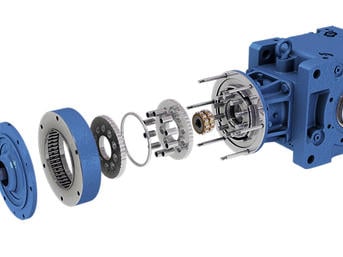Cyclo® Bevel Buddybox® 4 Series Gearmotor
Right Angle Spiral Bevel Gearmotors with Cyclo® Input
Robust, state-of-the-art, spiral bevel gearmotors.
- All-Steel Internal Components
- Highly Efficient
- Standard Ductile Iron Housing
- Integrated Cycloidal Technology
- Maintenance Free Options Available
| Input | Integral gearmotor, quill and C-face adapter |
| Output | Shrink Disc, Taper-Grip® Bushing, Solid Shaft, Keyed Hollow Bore, Screw Conveyor |
| Mounting | Hollow Shaft, Foot, Flange, U-Face (direct surface mount) |
| Sizes | 6 frame sizes (A-F), 48 to 1059 kg |
| Ratios | 11:1 to 26,000:1 and greater |
| Power Range | 1/8HP to 75HP (0.10kW to 55kW) |
| Torque Capacity | Up to 159,983 lb·in (17,400 N·m) |
| Motor Standards | NEMA, IEC, JIS, UL, CSA, CE |
Cyclo® BBB4
The Cyclo® BBB4 combines the strength and flexibility of the Cyclo® gear reducer and a single stage right angle spiral bevel gearbox in a rugged right-angle gearbox design. With a 24-month warranty, regardless of hours of operation, the Cyclo® BBB4 is an excellent choice for applications in material handling, asphalt mixers, specialty machine industries, conveyors, and other applications requiring right angle speed reducers.

Key Facts
Features

CAD / Configure
Select your level of product detail:
Learn more about our CONFIGURATOR TOOL:
FAQ
Do you have questions about the Cyclo® BBB4? Below are some of our most commonly asked questions, or you can view our Support area under Knowledge for more frequently asked questions and answers.
What are service factors and how are they used?
In general, reducers and gearmotors are rated for specific conditions and operating requirements of the application by the use of AGMA-defined Service Factors. There are three AGMA load classifications for reducers: uniform (U), moderate shock (M) and heavy shock (H), and three AGMA load classifications for gearmotors: I, II, and III. Refer to our catalog for a list of AGMA load classifications. These Service Factors are used in the product selection process to adjust for the specific conditions and operating requirements of your application.
How do I select a Cyclo® BBB4 reducer or gearmotor?
Visit our Cyclo® BBB4 Product Configurator at www.smcyclo.com/Configurator to find the exact match for your applications.
What is the difference in the mounting positions of the Cyclo® BBB4?
The mounting positions for the Cyclo® BBB4 detail the position of the unit relative to the driven shaft. The mounting position effects how the unit is assembled and maintained (i.e., location of oil fill ports, type of lubrication, breather location, etc.). You must specify the mounting position at the time of order.
What kind of torque arm do I specify? At what position should I mount it?
The standard torque arm assembly supplied is a turnbuckle type as shown in our catalog. The torque arm should be mounted at 90 degrees to a line from the point of attachment to the reducer and the center of the output bore with up to 30 degrees plus or minus variance. A bracket type torque arm is also offered as a non-stock option. In addition, we provide the Banjo-type and T-type torque arm mounting configurations.
What are the advantages of the new Steel Taper-Grip® bushing?
With an increased torque capacity, the new Steel Taper-Grip® bushing can be used in reversing and/or high start-up applications. The new Steel Taper-Grip®bushing can be used on all Taper-Grip® products.
What are the advantages of the Taper-Grip® bushing?
The Taper-Grip® bushing is integral to the Cyclo® BBB4 and provides for easy mounting and removal to and from the shaft of the driven machine. Because it requires no key way, the shaft isn’t weakened and maximum torque is transmitted.
What thermal capacity limitations does the Cyclo® BBB4 have?
The Cyclo® speed reducer, by virtue of its smooth, almost frictionless operation (unlike traditional helical gears), has a thermal rating that far exceeds its mechanical capacity and all but eliminates the conventional limitations due to heat.
What are Service Factors and how are they used?
In general, reducers and gearmotors are rated for the specific conditions and operating requirements of the application by the use of AGMA-defined Service Factors. There are three AGMA load classifications for reducers: uniform (U), moderate shock (M) and heavy shock (H). Refer to our catalog for a list of AGMA load classifications. These Service Factors are used in the product selection process to adjust for the specific conditions and operating requirements of your application.
What do I do if my application has particularly severe operating conditions?
The standard ratings for Cyclo® BBB4 are based on 10-hour daily service under conditions of uniform loads (equivalent to AGMA service factor 1.0). By following the product selection process outlined in our catalog, you will determine and apply the Service Factors to compensate for the severe operating conditions.









